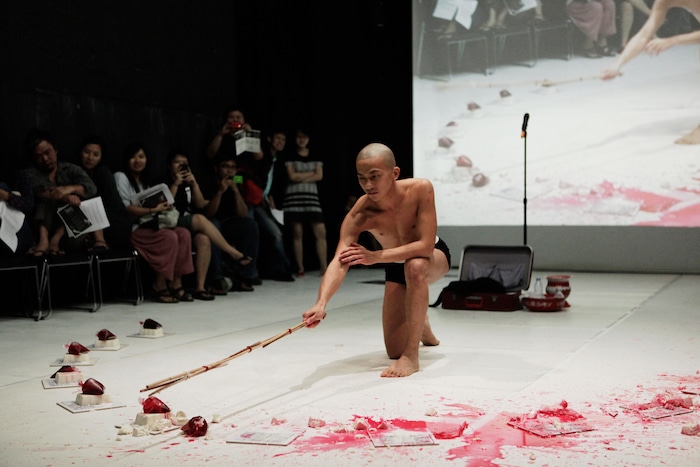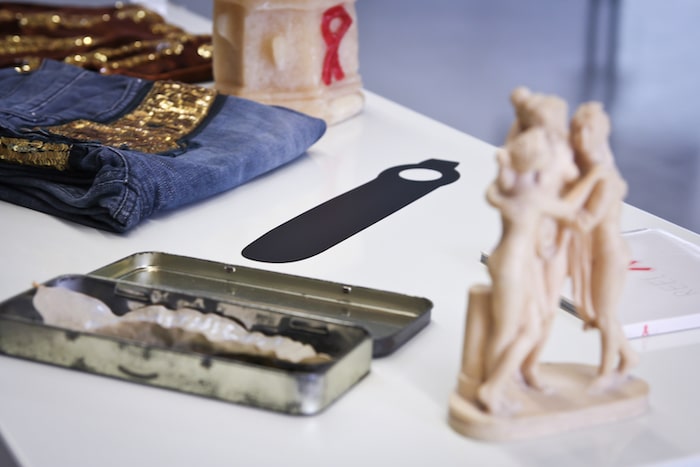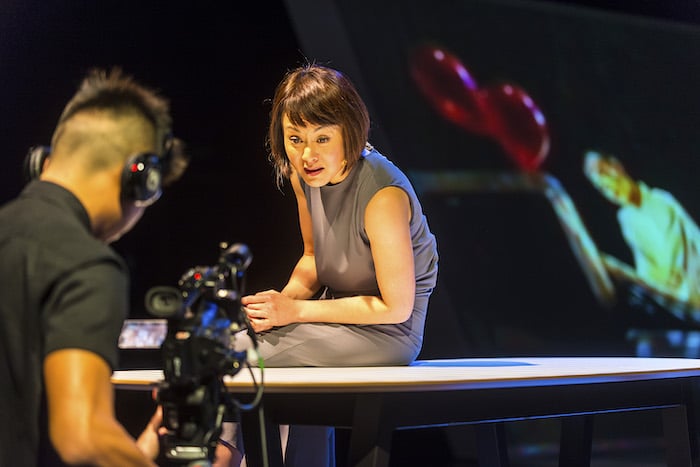Loo Zihan, the Singaporean Artist Who Dares to Bare in a Climate of Censorship
PUBLISHED December 31st, 2018 07:04 pm
Loo Zihan‘s coming show, Catamite – part of Singapore’s M1 Fringe Festival 2019 – is, like many of his other works, a meticulous investigation into history, memory, and identity. It leads us to confront our relationship with the objects around us and how we view the narratives surrounding them. But unlike his previous works, one can say Catamite deviates in how Zihan sends the message.
Back in 2012, it would be no surprise if people took “Loo Zihan baring all for art” literally. At the time, the artist had just returned to Singapore from completing his masters in Chicago and re-surfaced one of Singapore’s most known performance pieces (Josef Ng’s Brother Cane, 1994) through his own rendition entitled Cane (2012).

In his (re)performance, Zihan stands in front of his audience and presents six testimonials of Josef Ng’s Brother Cane in an attempt to reconstruct the memory of the event. While the performance was a moving historical account of Josef Ng’s performance, what made headlines instead was Zihan’s act of literally laying bare his nude body.
How do we remember an event and what best represents its narrative? For Zihan, it’s in being transparent, baring the hurdles artists face along the way and creating records to peel away the veneers that mask the true processes behind art production in Singapore – particularly focusing on the aspect of censorship.
Fast forward six years later to a quaint café in Bugis, where Zihan sits with his notebook open – revealing worn pages and scribbled notes – while flattening out a folded A4 printout of my pre-empted questions, preparing to bare his own history. Seeing him now, in his casual attire and bubbly intellect, it’s hard to believe he carries such a puissant repertoire.
He reads through the questions with a smile, his pen slowly rolling into the mild curve of the notebook’s worn down spine. “Instead of going through the list, maybe we just have a conversation first?” Zihan suggests as he looks up. The last time I had a conversation with Zihan was probably four years ago, when I was still his student, and it only occurred to me at that moment how little I knew about him.

“Well, where do you want me to begin?” Zihan laughs as he looks down. This simple question took me by surprise; how does one pinpoint a “beginning”? Everything has a beginning and an end; a past and future narrative that we are responsible of weaving. And here I am – like how Zihan has investigated history and memory in his works – I too have taken on the role of excavator and accounter of his history.
Zihan’s journey as an artist wasn’t always in the path of performance art. Starting as a technical intern for The Necessary Stage in 2001, Zihan was screwing cables and doing lighting, attributing that period as what laid the foundations to his art practice.
“If I didn’t plant the seeds with Alvin and Haresh [artistic director and resident playwright at The Necessary Stage] back in 2001, a lot of people think that I came back and did a performance and it was a sudden inclusion into the art scene, but it wasn’t immediate, it was a slow and long-term relationship that I’ve built with TNS who’s been supporting my work all these years”
Although he was exposed to theatre during his internship at The Necessary Stage, he pursued filmmaking in university followed by his masters. It was perhaps in this period of time that Zihan properly began his investigation and questioning of censorship.

Censorship had always been an interminable concern for Zihan. To the audience, the mechanics of censorship may only be felt in the level of movie ratings or bleeping of swear words, though to Zihan, as a Singaporean artist, “it’s a condition or production of being in Singapore that you cannot not think about.”
This condition is reflected in his work, where the presence of censorship can be felt undergirding his various performances. Whether it’s through exhibiting limitations imposed by the state – like going outside to smoke a cigarette in Cane – or through the outlining of removed objects in Queer Objects: An Archive for the Future (2016), Zihan had one way or another foregrounded its mechanics.
“There are always two people who are responsible for the act of censorship: There’s the state who censors the object and the artist who allows his object to be censored, so how can we as artists refuse this narrative?”
Catamite seems to mark a pivotal shift of direction in Zihan’s body of works, in the sense that it does not insert such obvious or more blatant confrontations with censorship. Rather than unveiling the man behind the curtain, Zihan bares a different narrative by shifting the spotlight onto the mundane and empowering the invisible.

What I found intriguing was how this shift in approach, while intentional and planned, came organically for Zihan, embedding his personal journey as an artist into his work – a journey that Zihan himself had taken in thoughtful, trialing strides. Our conversation pauses and the cafe’s background music seeps into the silence for a while.
“As a younger artist, you’re always indignant to make work so people will understand what you’re doing and why you’re doing it. You just want your voice to be out there and to be heard, so there’s an anxiety and desire to go for any platform you can and throw yourself out there. But now that I’m mid-career, that anxiety has toned down a little bit.”
Zihan continues to push the boundaries and potential of Singapore’s art scene, with Catamite as an impressive addition to Zihan’s body of works. Its subtle act of veering away from the sensational has proven to be an insidious step forward against being silenced. Whether it’s baring his body, his history, or the machinations of censorship and art making, Zihan proves to be an artist who dares to bare it all.
Part of Singapore’s M1 Fringe Festival 2019, Catamite is showing from 25 – 27 January 2019, at Black Box, Centre 42. Tickets can be purchased here for $27 and $19 concession for students, senior citizens, NSF, and PWD cardholders.


